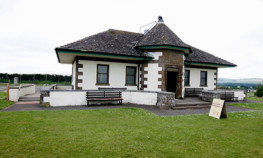An Angus landmark is among a number of Scottish sporting locations celebrated in a new Historic Scotland book.
Scotland’s Sporting Buildings was compiled by heritage listing experts, who visited hundreds of sites across the country for assessment.
And their findings have been compiled into an illustrated book by Nick Haynes.
The B-listed Barrie Sports Pavilion in Kirriemuir, pictured, built in 1929, joins more than 100 properties which have contributed to Scotland’s sporting character.
Dundee architect Frank Thomson presented novelist and Peter Pan creator Sir JM Barrie with the keys to a new cricket pavilion in 1929 before a reformed version of his cricket team, the Allahakbarries, played in an exhibition.
Local historian David Orr welcomed Kirrie’s addition to the book.
He said: “It is a much-photographed pavilion and I like the story of how Barrie used the gates of the cemetery as wickets when he was a kid.
“It was certainly the site of the greatest match when 10,000 people were on the hill to see Barrie’s team, the Allahakbarries, play the rest of Scotland.”
Sir JM Barrie’s side were named after the mistaken belief that ‘Allah akbar’ meant heaven help us in Arabic, and membership was a who’s who of Victorian literature HG Wells, Arthur Conan Doyle, Jerome K Jerome, GK Chesterton, AA Milne, and PG Wodehouse all played at one time or another.
Many of the pavilions, club houses, huts, stadia and swimming pools reviewed for the book had never been assessed before for listing, or had records which had not been updated for up to 40 years.
Mr Haynes said: “Scotland has always had a fascinating, sometimes tumultuous relationship with sport. Although most of the sports popular in our country today are accessible to everyone, this wasn’t always the case, and these buildings reveal a lot about the people who built them and the communities surrounding them.
“Hopefully, it offers a useful introduction to anyone interested in architecture, history or sport in Scotland.”
Scottish culture secretary Fiona Hyslop said: “For a relatively small country, we have had made several key contributions to the history of sport, with innovations that have shaped most of the world’s best played sports such as golf, rugby union and football, as well as curling, shinty, swimming, Highland games and others.
“This new book offers a fascinating insight into how this came to be.”
Some of the earliest buildings are associated with grand properties, showing the strong link between wealthy individuals and recreational pursuits.
Scotland’s oldest sporting building, the Royal Tennis Court at Falkland Palace, is a fine example of this, built in 1539-41 for King James V.
